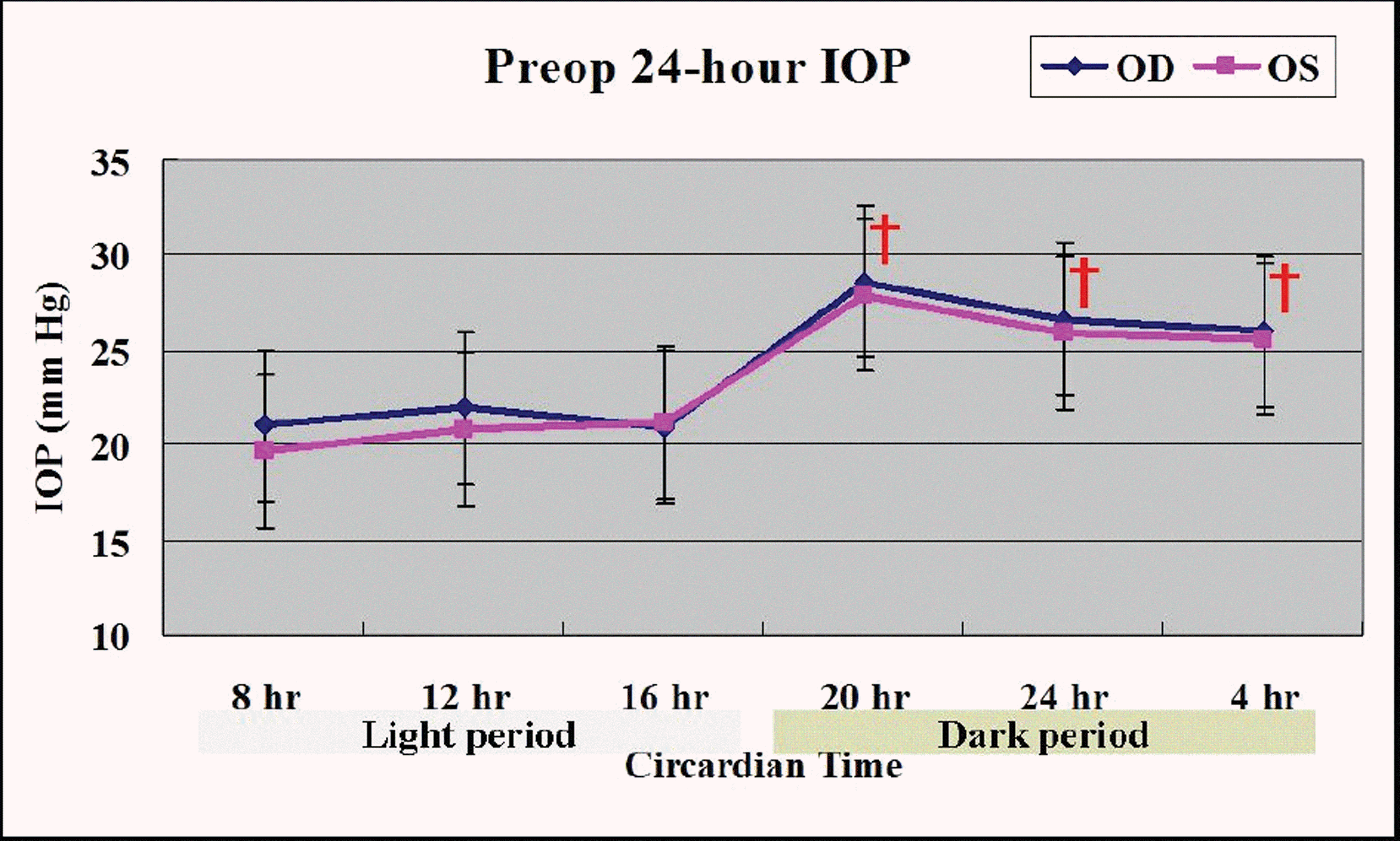Abstract
Purpose
The present study was undertaken to determine the 24-hour pattern of intraocular pressure (IOP), and to reveal the effect of unilateral decentralization on circardian rhythm of IOP in eyes of rats.
Methods
Nine male Sprague-Dawley rats were exposed to a 12-hour light/dark cycle for 3 weeks. 24-hours IOP pattern was measured at six time points (8, 12, 16, 20, 24, and 4 circardian time) by Tonopen XL tonometer in awake state. After unilateral sympathectomy (cervical ganglionectomy), IOP measurements were performed at the same time points on post-operation 1, 2, 3, and 4 weeks.
Results
24-hour IOP pattern of rats showed a rhythmic pattern that appeared to be sinusoidal with 12-hour light/dark cycle. IOPs were low during the light phase and high during dark phase. After unilateral sympathectomy, the circardian rhythm of IOP was maintained in control eyes. But in sympathecotmized eyes, the circardian thythm of IOP was loss.
Go to : 
References
1. Braslow RA, Gregory DS. Adrenergic decentralization modifies the circadian rhythm of intraocular pressure. Invest Ophthalmol Vis Sci. 1987; 28:1730–2.
2. Lee TC, Kiuchi Y, Gregory DS. Light exposure decreases IOP in rabbits during the night. Curr Eye Res. 1995; 14:443–8.

3. Peschke E, Peschke D, Huhn C. Circannual morphometric investigations of the rat suprachiasmatic nucleus after pinealectomy, ganglionectomy and thyroidectomy. Brain Res. 1996; 740:81–8.

4. Maeda A, Tsujiya S, Higashide T, et al. Circadian intraocular pressure rhythm is generated by clock genes. Invest Ophthalmol Vis Sci. 2006; 47:4050–2.

5. Shuba LM, Doan AP, Maley MK, et al. Diurnal fluctuation and concordance of intraocular pressure in glaucoma suspects and normal tension glaucoma patients. J Glaucoma. 2007; 16:307–12.

6. Dinn RB, Zimmerman MB, Shuba LM, et al. Concordance of diurnal intraocular pressure between fellow eyes in primary open-angle glaucoma. Ophthalmology. 2007; 114:915–20.

7. Sugimoto E, Aihara M, Ota T, et al. Effect of light cycle on 24-hour pattern of mouse intraocular pressure. J Glaucoma. 2006; 15:505–11.

8. Aihara M, Lindsey JD, Weinreb RN. Twenty-four-hour pattern of mouse intraocular pressure. Exp Eye Res. 2003; 77:681–6.

9. Moore CG, Johnson EC, Morrison JC. Circadian rhythm of intraocular pressure in the rat. Curr Eye Res. 1996; 15:185–91.

10. Yoshitomi T, Horio B, Gregory DS. Changes in aqueous norepinephrine and cyclic adenosine monophosphate during the circadian cycle in rabbits. Invest Ophthalmol Vis Sci. 1991; 32:1609–13.
11. Yoshitomi T, Gregory DS. Ocular adrenergic nerves contribute to control of the circadian rhythm of aqueous flow in rabbits. Invest Ophthalmol Vis Sci. 1991; 32:523–8.
12. Liu JH, Dacus AC. Central cholinergic stimulation affects ocular functions through sympathetic pathways. Invest Ophthalmol Vis Sci. 1990; 31:1332–8.
15. Vareilles P, Conquet P, Le Douarec JC. A method for the routine intraocular pressure (IOP) measurement in the rabbit: range of IOP variations in this species. Exp Eye Res. 1977; 24:369–75.

16. Morris CA, Crowston JG, Lindsey JD, et al. Comparison of invasive and non-invasive tonometry in the mouse. Exp Eye Res. 2006; 82:1094–9.

17. Avila MY, Múnera A, Guzmán A, et al. Noninvasive intraocular pressure measurements in mice by pneumotonometry. Invest Ophthalmol Vis Sci. 2005; 46:3274–80.

18. Erickson-Lamy KA, Kaufman PL, McDermott ML, et al. Comparative anesthetic effects on aqueous humor dynamics in the cynomolgus monkey. Arch Ophthalmol. 1984; 102:1815–20.

19. Mirakhur RK, Elliott P, Shepherd WF, et al. Comparison of the effects of isoflurane and halothane on intraocular pressure. Acta Anaesthesiol Scand. 1990; 34:282–5.

20. Thompson HS, Mensher JH. Adrenergic mydriasis in Horner's syndrome Hydroxyamphetamine test for diagnosis of postganglionic defects. Am J Ophthalmol. 1971; 72:472–80.
21. Perreau-Lenz S, Kalsbeek A, Garidou ML, et al. Suprachias- matic control of melatonin synthesis in rats: inhibitory and stimulatory mechanisms. Eur J Neurosci. 2003; 17:221–8.
22. Gupta N, Yücel YH. Glaucoma in the brain: a piece of the puzzle. Can J Ophthalmol. 2006; 41:541–2.

23. Liu JH, Dacus AC. Endogenous hormonal changes and circadian elevation of intraocular pressure. Invest Ophthalmol Vis Sci. 1991; 32:496–500.
24. Liu JH, Dacus AC, Bartels SP. Adrenergic mechanism in circadian elevation of intraocular pressure in rabbits. Invest Ophthalmol Vis Sci. 1991; 32:2178–83.
25. Rohrer DK. Physiological consequences of beta-adrenergic receptor disruption. J Mol Med. 1998; 76:764–72.
26. Patel TB, Du Z, Pierre S, et al. Molecular biological approaches to unravel adenylyl cyclase signaling and function. Gene. 2001; 269:13–25.

27. Honma S, Kawamoto T, Takagi Y, et al. Dec1 and Dec2 are regulators of the mammalian molecular clock. Nature. 2002; 419:841–4.

Go to : 
 | Figure 1.Twenty-four-hour IOP pattern of SD rats exposed to 12-hour light/dark cycle. Circardian rhythm of IOP showed a biphasic pattern that appeared to be sinusoidal with 12-hour light/dark cycle. In the dark period, more elevated IOPs were checked than in the light period ( P<0.01). † indicates that IOP of rats in the dark period was higher than in the light period. |
 | Figure 2.Change of 24-hours IOP pattern of rats after unilateral cervicalganglionectomy. After unilateral sympathectomy, the circardian rhythm of IOP in unoperated side was maintained as similar pattern in pre-sympathectomy. But in operated side, the circardian thythm of IOP was disappeared. At 1 and 2 weeks, there was a difference of IOP in both eyes in the light & dark period. But after 3 weeks, the difference of IOP in both eyes can be only seen in the dark period ( P<0.01).* indicate the points that present difference of IOP in both eyes; OD=eye of operated side; OS=eye of unoperated side. |




 PDF
PDF ePub
ePub Citation
Citation Print
Print



 XML Download
XML Download